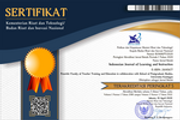THE EFFECT OF KAHOOT APPLICATION IN IMPROVING STUDENTS’ WIRTING SKILL (QUASI EXPERIMENTAL DESIGN AT SMAN 1 LURAGUNG)
Abstract
The research aimed to find out whether or not there is an effect of using Kahoot Application in improving students’ writing skills. The method used in this research was quantitative method with a quasi-experimental design. The population of students at the Second grade was 134 students of Senior High School 1 Luragung with two sample classes which have 12 students in each class. Both classes are assigned into experimental and control class. In obtaining the data, the researcher conducted pre-test, treatments, and post-test. The treatment was given to the experimental class 4 times assissted by Kahoot application. Meanwhile, in control class there is no treatment given. The teaching was assisted by Google classroom. The result of the data showed that the mean scores of the experimental class pre-test and post-test rater 1 was 56.44 and 78.66 from rater 2 was 56.58 and 79.75. On the other hand, the mean scores of Control group pre-test and post-test rater 1 was 50.55 and 68.00 from rater 2 was 52.00 and 67.83. The students’ better achievement toward writing ability can be seen on the mean score from descriptive statistic of the post-test the experimental class rater 1 and 2 was 67.85 higher than the mean score of post-test in the control class which was 59.58. It can be concluded that, the students who got treatment using Kahoot were higher than the students’ from the control class. Kahoot application given a positive effect on the students’ writing skills and also the effective online learning during COVID-19 Pandemic.
Keywords: writing skill; Kahoot.
Full Text:
PDFReferences
Acquah, E. O., & Katz, H. T. (2020). Digital game-based L2 learning outcomes for primary through high-school students: A systematic literature review. Computers & Education, 143.
Dellos, R. (2015). Kahoot! A digital game resource for learning. Instructional Technology.
Fraenkel, J. R., & Wallen, N. E. (2009). How To Design and Evaluate Research in Education (7th ed). New York: Mc Graw Hill Company Inc.
Hashim, H. U., Yunus, M. M., & Hashim, H. (2018). (2018). Language learning strategies used by adult learners of Teaching English as a Second Language (TESL). TESOL International, 39.
Jacobs, H. L., Zingraf, S. A., Wormuth, D. R., Hartfiel, V. F., & Hugher, J. B. (1981). Testing ESL Composition: A Practical Approach. Rowley: Newbury House Publishers, Inc., 115-116.
Johns, K. (2015). Engaging and assessing students with technology: A review of Kahoot! Delta Kappa Gamma Bulletin. 81(4), 89.
Kapuler, D. (2015). Top 100 sites and apps of 2014 Teach & Learning. . Technology & Learning, 35 (66), 14-16.
Kletnikov, N., Popovski, O., & Tomova, A. (2019). Kahoot! foster students’ engagement, enhance classroom dynamics, assess and improve overall students’ learning. Proceedings of Papers, 24.
Langnan, J. (2005). College Writing Skills with Reading. (6th ed). New York: The McGraw-Hill Companies Inc.
Siegle, D. (2015). Technology: Learning can be fun and games. Gifted Child Today, 38(3),, 192–197.
Wang, A. I., & Lieberoth, A. (2015). The effect of points and audio on concentration, engagement, enjoyment, learning, motivation, and classroom dynamics using Kahoot!. In Conference: 10th European Conference on Game Based Learning 2016. At Paisley Scotland.
DOI: https://doi.org/10.25134/ijli.v5i1.5873
Refbacks
- There are currently no refbacks.
Copyright (c) 2022 Indonesian Journal of Learning and Instruction

This work is licensed under a Creative Commons Attribution-NonCommercial-ShareAlike 4.0 International License.

